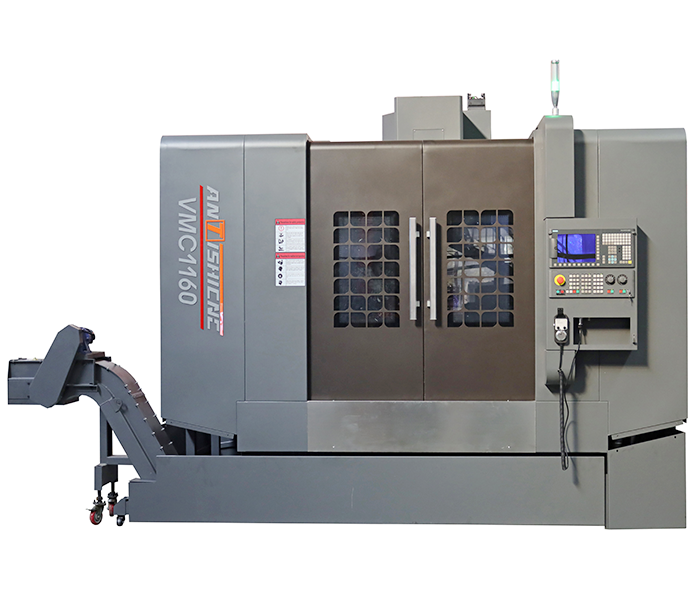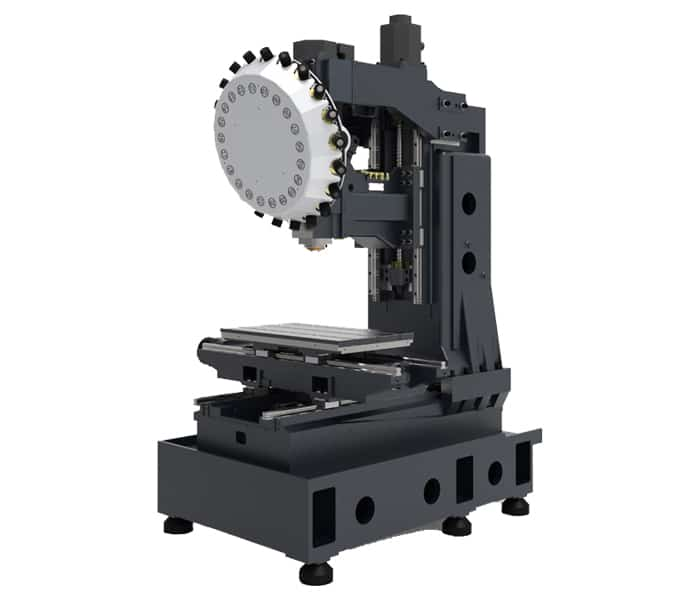Vertical machining centers and drilling and tapping machining centers are commonly used equipment in the field of CNC machining. The two have both similarities and obvious differences in structure, function, and application scenarios.The following compares and analyzes them from multiple dimensions:
Ⅰ.Core functions
1.Vertical machining center
Refers to a machining center whose main axis is perpendicular to the workbench, and usually has three linear motion axes (X, Y, and Z axes). Some models can extend the fourth axis and the fifth axis (rotation axis).
Core functions:
It has various processing capabilities such as milling, drilling, boring, reaming, tapping, etc.
It is suitable for processing complex plane, curved surface, and box parts, such as molds, flanges, gearboxes, etc.
Through the tool change system (the tool bank has a large capacity, and 24/32/40 knives are common), multi-process continuous processing is realized, the number of workpiece clamping is reduced, and the accuracy and efficiency are improved.
2.Drilling and tapping machining center (drilling and tapping machine)
Definition: High-speed processing equipment with drilling and tapping as its core functions belongs to the subdivision type of vertical machining centers, but it focuses more on high-speed and high-precision small hole machining and thread machining.
Core functions:
It mainly focuses on high-speed drilling (such as holes with a diameter of 0.5-20mm) and tapping (especially small pitch threads, such as M1-M12).
Some models can take into account simple milling, but the milling capacity is weaker than that of traditional vertical machining centers.
Equipped with a high-speed spindle (the speed is usually 10000-24000rpm) and a fast feed system, it is suitable for mass production of small and medium-sized parts, such as 3C product housings, electronic accessories, medical device parts, etc.
Ⅱ. Key performance comparison
| Performance | Vertical machining center | Drilling and tapping machining center |
| Picture |  |
 |
| Spindle speed | Generally 4000-8000rpm, some high-end models can reach 12000rpm | Generally 10000-24000rpm, high-speed models can reach 30000rpm |
| Feed speed | Usually 10-20m/min | Up to 40-60m/min, some models have a fast moving speed of more than 80m/min |
| Tool magazine capacity | Larger (24-120 pieces), suitable for complex multi-process processing | Smaller (16-32 pcs), mainly drilling/tapping tools |
| Positioning accuracy | Generally ±0.005-0.01mm | Higher, up to ±0.002-0.005mm, suitable for precision machining |
| Machine rigidity | Heavy structure, suitable for heavy cutting (such as steel parts, cast iron parts) | Compact structure, lightweight, focusing on high-speed and light cutting (such as aluminum alloy and copper parts) |
| Processing object | Large-size, complex structural parts (such as molds, large boxes) | Small and medium-sized parts, especially those with dense hole positions and high thread accuracy |
| Typical workpiece material | Hard materials such as steel, cast iron, alloys, etc. | Aluminum alloy, copper alloy, plastic, stainless steel (small pieces) |
Ⅲ. Structural characteristics
1.Vertical machining center
Fuselage structure:
The column and workbench are usually castings, which have strong rigidity and can withstand large cutting forces.
The headstock moves vertically (Z axis) and the workbench moves horizontally (X/Y axis), which is suitable for heavy-duty machining.
Accessory configuration:
It can be equipped with a fourth axis (indexing plate) or a five-axis linkage function to expand the surface processing capacity.
Equipped with a cooling system and chip removal device, it is suitable for long-term continuous processing.
2.Drilling and tapping machining center
Fuselage structure:
The structure of fixed columns and movable workbench is adopted, which is light in weight and fast in response.
The headstock design is compact, and some models adopt a ”drilling and tapping machine” structure to reduce non-machining time (such as tool change speed <1 second).
Accessory configuration:
Standard high-speed spindles (often direct-coupled or electric spindles) are equipped to reduce transmission losses.
Equipped with high-precision linear guides and screws to ensure stability under high-speed movement.
Ⅳ. the application scenario
1.Vertical machining center
Applicable industries: mold manufacturing, auto parts, aerospace, heavy machinery, etc.
Typical processing scenarios:
To process the cavities and cores of injection molds, large planes, deep cavities, and complex curved surfaces need to be milled.
Machining the gearbox housing requires a combination of drilling, boring, tapping and plane milling.
Processing large flanges requires heavy cutting to remove a large amount of material.
2.Drilling and tapping machining center
Applicable industries: consumer electronics (3C), medical equipment, precision machinery, hardware accessories, etc.
Typical processing scenarios:
To process the middle frame of a mobile phone and the shell of a laptop computer, dozens of small holes need to be drilled and tapped at high speed.
For processing watch parts and medical device joints, high-precision threads (such as M1.2) and micro-holes are required.
Mass production of electronic connectors requires rapid completion of drilling, chamfering, simple groove milling and other processes.
Ⅴ. How to choose?
Preference for vertical machining centers:
Processed products are large in size and high in material hardness (such as steel parts).
It requires complex milling and multi-axis linkage machining (such as curved surfaces and cavities).
The process is complex and requires frequent replacement of different types of tools (such as milling cutters, boring cutters, and drill bits for mixed use).
Preference for drilling and tapping machining centers:
Drilling and tapping are the main processes, taking into account simple milling.
The processing materials are light metals or plastics such as aluminum alloy and copper alloy.
The pursuit of high production efficiency (such as high-volume parts) and high-precision thread processing.
Ⅵ. Maintenance and cost
Vertical machining center:
The procurement cost is relatively high, and the maintenance cost is high (the spindle and guide rail need to be maintained regularly).
Suitable for large enterprises or complex parts with high machining accuracy requirements.
Drilling and tapping machining center:
Procurement costs are lower, and maintenance focuses more on spindle cooling and screw lubrication.
Suitable for small and medium-sized enterprises or mass production scenarios, with a short return on investment cycle.
Summary
Vertical machining centers are “all-around players“, suitable for the whole process processing of complex parts; drilling and tapping machining centers are ”specialized players”, known for high-speed and high-precision hole processing and thread processing.When choosing, it is necessary to consider the workpiece material, size, processing technology, production efficiency and budget comprehensively.With the development of the 3C industry and precision manufacturing, the application scenarios of drilling and tapping machining centers are constantly expanding, and vertical machining centers are still the core equipment for mold and heavy machinery processing.
Shanghai ANTS is a professional manufacturer of machining centers. We have rich production and processing experience. We can recommend the most suitable CNC milling machine for your products and give suitable suggestions for use. We can provide you with professional technical support.We mainly have vertical machining centers, horizontal machining centers, gantry machining centers, etc.
Keywords: Vertical machining center, Drilling and tapping center, CNC milling machine, VMC


